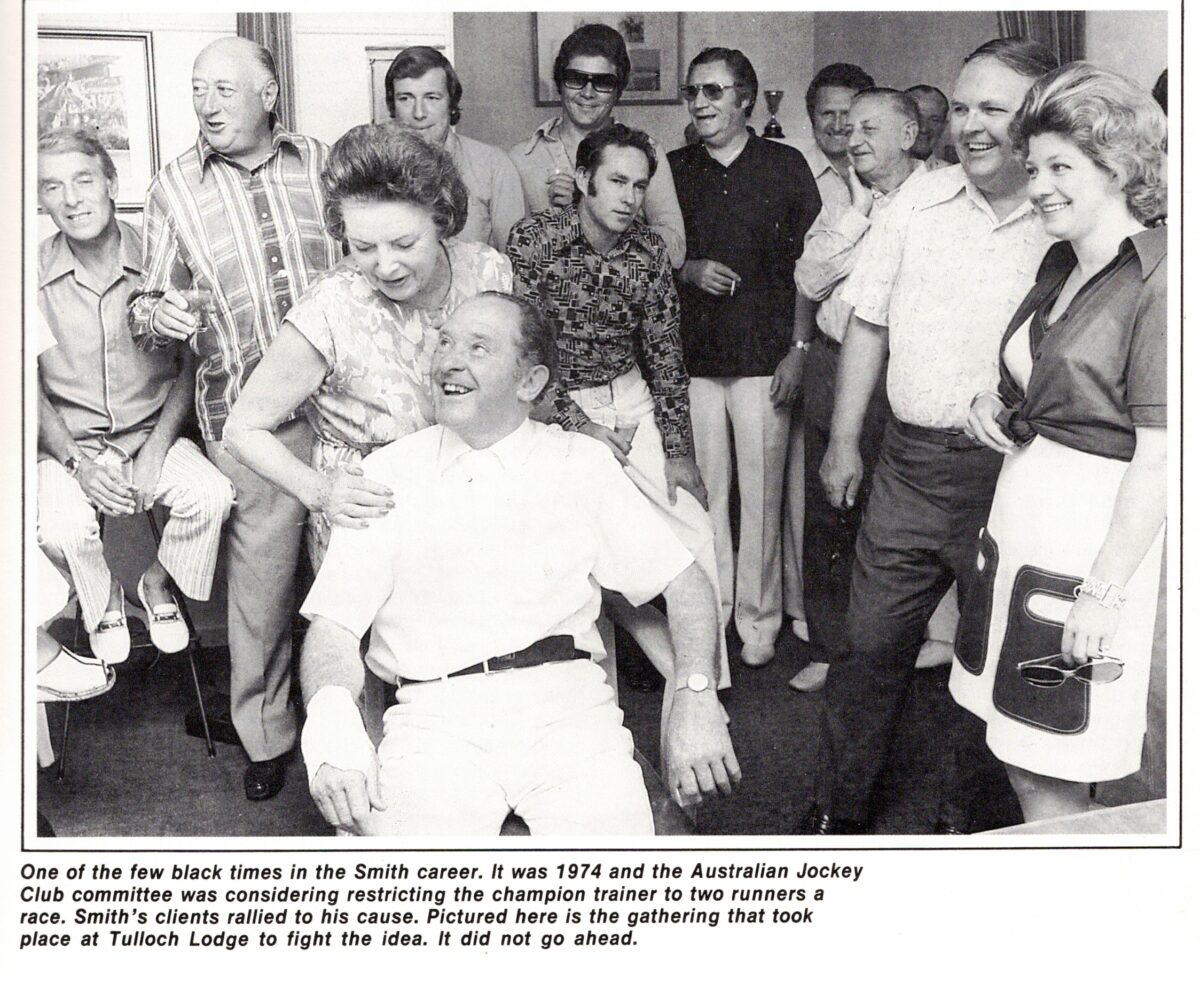Tulloch Lodge Tribunal 1974
Featured Image: Tulloch Lodge 1974 Gratefully acknowledge ‘Backstage of Racing’ by Bert Lillye ISBN 0 909558 86 8 © Copyright 1985 John Fairfax Marketing, The Herald Building, 2nd Floor, 23 Hamilton Street, SYDNEY NSW 2000.
The image includes T J & Valerie Smith, Dave ‘The Dasher’ Segenfield, Phil Spanton, John McSweeney (dark glasses), Tony McSweeney (dark glasses & dark shirt), Ralph Lucas, Ferd Calvin and Mrs Spanton; a veritable ‘Cadre of Colourful Racing Identities’. An ageing colleague attending our regular Wednesday ‘Camarilla of Coffee Cadre’ at a Cafe in Kelly Street remarked with some perspicacity that ‘characters’ were disappearing from our everyday lives and not just from the racetrack?
T J Smith was at the apogee of his dominance of thoroughbred training in Sydney if not Australia in 1974. The AJC’s move to restrict the number of runners a trainer could have in any given race stemmed from favourite ‘Foresight’ being run down by 80-to-1 outsider ‘Bye Bye’, one of TJ’s five runners, in the 1969 Doncaster. ‘Foresight’ was backed for a motzer at odds between 16/1 and 20/1 and in doubles with ‘Lowland’ (Sydney Cup) and ‘Rain Lover’ by a trusted commission agent weeks in advance of the race for a leviathan AJC Committeeman. Was it time for ‘payback’?
It’s intriguing to speculate how this proposed rule if applicable today would affect race fields. It’s not unusual for Chris Waller to accept with most runners in many Sydney Metropolitan Races, especially those over middle distances and restricted class staying races.
Kobayashi Quinella in Pat O’Shea Plate
See: https://www.breednet.com.au/news/24033/kobayashi-quinella-in-pat-o’shea-plate-
Mark Smith – Toowoomba, Saturday 23 September 2023
Trainer Less Ross and owner Mike Cooks’ Mishani Enterprises had six of the nine starters for the first 2-year-old race of the season, Saturday’s Pat O’Shea 2yo Plate (1000m) at Toowoomba, and duly supplied the trifecta.
The outsider of the sextet, ‘Mishani Rock’, handed the hammer blow to punters.
Ridden by Les Tilley, the son of Kobayashi was strong to the line in defeating the Kobayashi filly ‘Mishani Ego’ by one and a half lengths, with The Mission filly ‘Mishani Fire’ back in third.
“It was a pleasant surprise. I was hoping one of the fillies would win, but it’s nice to have a winner,” Ross said.
Of those gathered at Tulloch Lodge in 1974 a small few were subsequently ‘warned off’ for a variety of real or perceived misdemeanours ‘incompatible with the rules of racing’. Afficionados of the sport will recognise who they were?













